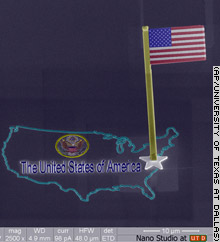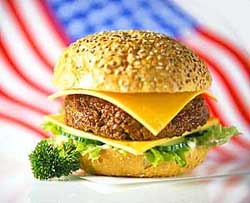Apparently in Texas, you need a high-tech microscope in order to see patriotism at work. CNN News  reported yesterday that electrical engineering graduate students Jang-Bae Jeon and Carlo Foresca at the University of Texas at Dallas succeeded in building a mini-American flag. This flag isn’t just any mini-flag, however, it’s a nanoflag.
reported yesterday that electrical engineering graduate students Jang-Bae Jeon and Carlo Foresca at the University of Texas at Dallas succeeded in building a mini-American flag. This flag isn’t just any mini-flag, however, it’s a nanoflag.
The flag built at UT Dallas is so small that it would take 10 of them to span the width of one human hair, reports CNN.
This was an experiment in what scientists call nanotechnology—the study of very little things. Despite the flag’s microscopic size (7 microns, to be exact), it has not been recognized by the Guiness Book of World Records, which claims they have no method of actually seeing the flag.
To put things in perspective, check out the National Nanotechnology Initiative’s “The Scale of Things”. As you can see from this chart, the flag built at the University of Texas is smaller than the head of a pin, a dust mite, and a human hair. It measures somewhere in the range of a red blood cell.
While the mini-flag-building escapades at UT may seem a bit superfluous, nanotechnology is a growing scientific field that holds high hopes for disease research and regenerative medicine. An offshoot, called nanomedicine, focuses on altering cells at the molecular level in order to cure diseases, such as cancer, before they even start. The National Institute of Health’s Roadmap Nanomedicine Program is confident that major breakthroughs in nanomedicine will happen in 10 years or less. NIH plans to develop its nanomedicine program in order to gain the ability to fix broken cells, the source of many deadly diseases.
Nanotechnology may have other applications, as well. Several European governments have recognized that nanotechnology may seriously impact the food industry. For example, Helmut Kaiser Consultancy (Switzerland) conducted a study recently that reported that the “nanofood market will surge from $2.6 billion today to 20.4 billion in 2010”. According to this study, the US and Japan are the countries leading research in “nanofoods”. The Royal Society (UK) conducted a similar study in 2004, corroborating the potential of nanofoods, but also cautioned against unknown side affects caused by humans ingesting “nanoparticles”.
According to these studies, nanotechnology will be used in the future to monitor and judge the freshness of food, as well as to improve food safety. In addition, the studies maintain that “in the future, food will be designed by shaping molecules and atoms.” As a result, it is possible that nanotechnology could have a very positive influence on the efficiency, healthiness, and productivity of the food processing industries. The studies also claim that food in the future will be less expensive due to improvements in nanotechnology.
Scientists’ faith in nanotechnology is so strong that Kellogs’ recently replaced its usual games, puzzles, and health articles on its cereal boxes with articles about nanotechnology. Its German cereal, “Toppas” will no longer have fun pictures to amuse breakfasters while they eat. Instead, the boxes will include pictures and information about nanotechnology in order to get their customers used to the idea of nanofoods.
health articles on its cereal boxes with articles about nanotechnology. Its German cereal, “Toppas” will no longer have fun pictures to amuse breakfasters while they eat. Instead, the boxes will include pictures and information about nanotechnology in order to get their customers used to the idea of nanofoods.
While this nanotechnology is truly amazing and full of potential, I think I would rather stick to my mega-burger. The idea of scientists altering the molecular make-up of my food is kind of disturbing. No nano-burgers for me, thanks!
Sign up today to have our latest posts delivered straight to your inbox.